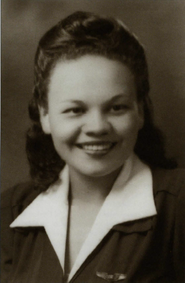
Mildred, then a seventeen-year-old student, worked in the office that handled CPTP applications. In a recent interview, she remembered watching male students clamor to sign up for the program. "I thought, 'I could do that."' And she did. Under the guidance of instructor George Allen, she secured her pilot's license in 1941. At the time, there were only about a hundred black licensed pilots in the nation and only a handful of black women. A few months later, women would be banned from the CPTP; as war approached, the country needed only male pilots, or so the government decided.
In the spring of 1941, Mildred was in the air over Kennedy Field, the civilian airstrip where CPTP students trained. She had her hair pulled back and wore a smart leather flying jacket, a gift from her parents. Down below, a famous woman was visiting. Eleanor Roosevelt had come to Kennedy Field to see black men taking to the air. What she soon learned was, so were a few black women.
When Mildred stepped down from her Piper Cub, she was told there was someone who wanted to meet her. "Mrs. Roosevelt was very gracious; I was tongue tied," Mildred remembered. The First Lady confided to Mildred that Amelia Earhart had once promised to give her flying lessons. That is, before Earhart disappeared over the Pacific in 1937.
Tuskegee photographer P.H. Polk caught Mildred's moment with Mrs. Roosevelt. Also photographed, sporting a giant "T" on his university jersey, was another student pilot. His name was Daniel "Chappie" James Jr.; he went on to become the first black four-star general in the Air Force.
James didn't know it at the time, but Mrs. Roosevelt's fact-finding visit helped secure his military career. Her report helped persuade the president to allow black fliers to be considered for combat. Of course, it was only male black fliers who were considered. Mildred's desire to aid her country from the air was thwarted at every turn.
The First Lady confided to Mildred that Amelia Earhart had once promised to give her flying lessons. That is, before Earhart disappeared over the Pacific in 1937.
Mildred kept trying. With Chief Anderson' encouragement, she offered her talents to the Army. Her letter of rejection is lost now, but Mildred recalls it came from none other than the famous aviatrix, Jackie Cochran. In 1939, Cochran sought Mrs. Roosevelt's help in creating a women's flying division under the military. By 1942, she had established the Women's Flying Training Detachment, which ultimately merged with the Women's Auxiliary Ferrying Squadron to form the legendary Women Airforce Service Pilots (WASPs).
Cochran tried to explain the absence of African American WASPs in her 1954 autobiography, The Stars at Noon. She said most black women who applied simply didn't have the required training or flying experience. But she also insisted that the politically tenuous program could have been jeopardized had a black pilot been admitted. In fact, Cochran aid she made that argument to the first black woman applicant who had the qualifications to be a WASP. Cochran didn't name the woman in her book, but she said the woman withdrew her application.
Now eighty-one, Mildred said life at Tuskegee Institute had insulated her from much of segregation's uglier elements, but the brick wall she hit as a flier brought it home. Mildred remembers it as "the most deva taring time of my teenage years."
And yet, aviation would always be central to Mildred's life. At Tuskegee, Mildred met her husband-to-be, Herbert Carter. He, too, went through the CPTP and then advanced training before joining the Army Air Corps as a cadet. Hertbert became a member of the 99th Pursuit Squadron, better known as the Tuskegee Airmen.
Mildred and Herbert actually courted in the air. Although Herbert was confined to segregated Tuskegee Army Airfield during training, he phoned Mildred to let her know when he would be flying. Mildred rushed to Kennedy Field, and soon the two were waving to each other-he from an AT-6, she from a Piper Cub-while zooming over Lake Martin. They were married in 1942 at the Tuskegee Army Airfield chapel. Like Kennedy Field, Tuskegee Army Airfield has disappeared from the Macon County landscape.
During World War II, Mildred worked as a clerk at Moton Field and at Tuskegee Army Airfield. In the years after the war, she was a military wife, following Herbert across the nation and Europe while raising three children. The couple eventually returned to Tuskegee, where Herbert, a retired Air Force lieutenant colonel, worked as a professor and an associate dean. Today, Mildred and Herbert still love to travel, often attending events honoring the Tuskegee Airmen. Indeed, among her fellow male pilot trainees at Tuskegee or her Tuskegee Airmen brothers, Mildred never felt prejudice. "I was one of the boys, and still am," she said.
This feature was previously published in Issue 68, Spring 2003.
About the Author
Michael Sznajderman is a former newspaperman and part-time freelance writer. He works full-time in corporate communications.
 RSS Feed
RSS Feed